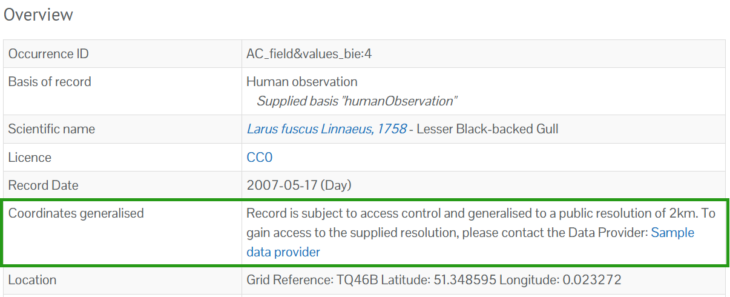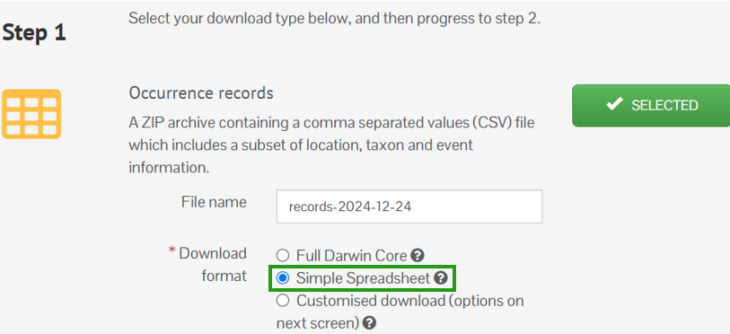This page will provide an overview of Access Controls, covering the following topics:
For specific guidance on requesting access to Access Controlled data, please see here. For specific guidance on managing and allowing access to NBN Atlas users for Access Controlled data, please see here. |
Glossary of Access Control related terms
| Resolution – The spatial uncertainty of a record based on the grid reference or coordinate uncertainty in meters, see Grid and coordinate based records on the NBN Atlas for further guidance.
Public resolution – The coordinate uncertainty or grid square size that the record is viewable at on the NBN Atlas. For Access Controlled datasets this will be 1, 2, 5 or 10km grids. Supplied resolution – The coordinate uncertainty or grid square size as supplied by the data partner in the original datafile. Location – Refers to the grid reference, latitude and longitude coordinates, coordinate-uncertainty and the locality text for a record. Generalised – When the supplied resolution is higher than the resolution displayed on the NBN Atlas (either according to a set public resolution or the sensitive species lists). |
What are Access Controls?
Access Controls are the newly updated functionality allowing data partners to request a set public resolution be applied to all records in a dataset on the NBN Atlas and to give individuals access to the supplied location information via downloads from the NBN Atlas.
Access to the supplied resolution of generalised sensitive species records will also be managed through Access Controls. For further information on how sensitive species are handled on the NBN Atlas, see here.
How is a public resolution applied?
Data partners can request a set public resolution to be applied to new and existing datasets (also referred to as ‘data resource’ on the NBN Atlas).
For new datasets data partners will need to specify the public resolution they want applied in the metadata form, which must be supplied with the data (see Share species occurrence records).
For existing datasets please email data@nbnatlas.org with the name of the dataset and the public resolution (1, 2, 5, or 10km) you would like to be applied. The public resolution will then be applied to your dataset after the next data processing (see the Data processing schedule).
The set public resolution is then specified on the dataset’s page on the NBN Atlas:

What record information is affected?
The table below lists the fields affected by Access Controls and how they are affected when a public resolution is set.
| Field name/s | How the field is affected |
| Grid reference |
The grid reference is generalised to the set public resolution. E.g., For a record supplied with a 1m grid reference in a dataset with a 1km set public resolution, the grid reference will be generalised to 1km. However, if the supplied resolution is lower than the set public resolution, the grid reference will not be changed and will remain with the supplied resolution. E.g., For a record supplied with a 10km grid reference in a dataset with a 1km set public resolution, the grid reference will be the supplied 10km grid reference. |
| Coordinate uncertainty in meters |
The coordinate uncertainty in meters is generalised to the set public resolution. E.g., For a record supplied with a coordinate uncertainty (m) of 50 in a dataset with the set public resolution 1km, the coordinate uncertainty will be generalised to 707.1 (1km). However, if the supplied resolution is lower than the set public resolution, the coordinate uncertainty in meters is the supplied resolution. E.g., For a record supplied with a coordinate uncertainty (m) of 1000 in a dataset with the set public resolution 1km, the coordinate uncertainty (m) will be the supplied value (which is equivalent to a 2km grid square on the NBN Atlas). |
| Latitude and longitude |
If values are supplied for the Latitude and Longitude fields, the values will be processed and generalised according to the processed coordinate uncertainty in meters. If no values are supplied for the Latitude and Longitude fields, the NBN Atlas will calculate and display the generalised values according to the processed grid reference. |
| Locality | This field is cleared for all records affected by Access Controls (i.e., those with a set public resolution and/or are of a sensitive species). |
For sensitive species, records will be generalised to the set public resolution for the dataset or according to the relevant sensitive species list (see guidance on sensitive species lists here). If the set public resolution is higher than the generalisation in the sensitive species list, the record will be generalised according to the sensitive species list.
How to identify records being displayed at a set public resolution on the NBN Atlas
This sections covers how to identify records being displayed at a set public resolution when searching the NBN Atlas or in downloads from the NBN Atlas.
In the occurrence search
For records in a dataset where a public resolution is set, the set public resolution is displayed (e.g. 2km), along with a padlock icon:

This does not currently apply to records generalised according to the sensitive species lists, i.e., records of sensitive species. Therefore, records without a set public resolution in an occurrence search may be generalised.
On the record page
The Coordinates generalised field is included in the Overview section, indicating the record is subject to a set public resolution and to access the supplied resolution, the data partner will need to contacted:

If the record has a set public resolution and is also a sensitive species, text will be included to infer if the record is being displayed according to the set public resolution or a sensitive species list:
If the sensitive species record has a supplied or set public resolution lower than the generalisation in the relevant sensitive species list (i.e., the location was supplied already generalised or has been generalised by the set public resolution):

If the sensitive species record has a supplied resolution higher than the generalisation in the relevant sensitive species list (i.e., the location has been generalised according to the sensitive species generalisation):

The Coordinates generalised field is also included in the Geospatial section (towards the bottom of the page), along with the Public resolution in meters field:

In the occurrence download
The public_resolution_in_meters field is included in the Simple Spreadsheet download, and indicates the set public resolution for a record:

The value in this field is corresponds to the grid size in meters, i.e., in the example above, 2000 represents a 2km grid square uncertainty.
Please note that currently this will not indicate if a record has been generalised according a sensitive species list. For now you will need to refer to the sensitive species lists.
Requesting and managing access
Currently NBN Atlas users will need to request access to the supplied resolution externally from the NBN Atlas (i.e., via email). The data partner can then allow access to the supplied resolution for a specified NBN Atlas user. Data partners can specify which records a user can have access to, e.g., all records in a dataset, for a specified species etc.
The data partner will need to know the following to set up appropriate access for a NBN Atlas user [the requester]:
|
If you are a requester or a data partner setting up access for a NBN Atlas user, please use/share the Request access to supplied resolution form to help collect the information above.
How higher resolution data is made available
When a data partner allows access for a NBN Atlas user to the supplied resolution, they will not be able to see the supplied resolution for records’ location on the NBN Atlas, currently. The NBN Atlas user will need to navigate to a search with the records and download the records, using the Simple Spreadsheet format to access the supplied resolution for the records’ location.

Currently other download formats are not supported for accessing the supplied resolution.
When a NBN Atlas user completes a download, with records which they have been granted access to the supplied resolution for the records’ location, these additional fields will be included:
| Field name | Description |
| Locality – access controlled | Supplied locality text. |
| Grid reference – access controlled | The supplied or processed grid reference at the supplied resolution. |
| Longitude – access controlled | The supplied or processed longitude at the supplied resolution. |
| Latitude – access controlled | The supplied or processed latitude at the supplied resolution. |
| Coordinate uncertainty (m) – ungeneralised | The supplied or processed Coordinate uncertainty (m) at the supplied resolution. |
For records which are not affected by Access Controls or the NBN Atlas user has not been granted access to the supplied resolution, these fields will be blank.
